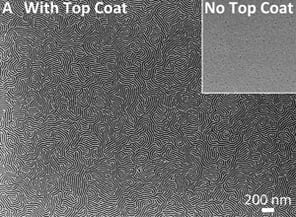Fabrication Trick Offers Fivefold Leap in Hard-Disk Capacity
A technique that enables the nanopatterned layers that store data in hard disk drives to assemble themselves has been improved to better suit mass production, and could enable disks that store five times as much data as the largest available today.

Using self-assembly instead of machines that print or etch out features has long been considered a potential solution to a looming barrier to expanding the capacity of hard-disk designs. Researchers at the University of Texas at Austin have now worked out a solution to a problem that made self-assembly incompatible with existing factories.
Hard disks store data on a spinning disk, written into a pattern of magnetized regions on a magnetic coating. For decades, gains in hard-drive capacity have come from packing those regions—and hence data—more densely. But now they can’t be positioned much closer together without magnetic interference endangering the reliability of data storage.
Covering a disk platter with physically separate dots of magnetic material instead of a continuous coat would allow much denser storage, since interference between the dots would be prevented by the gaps between them. But existing manufacturing methods can’t reliably make discrete islands spaced closer than about 30 nanometers apart, producing much the same data density as conventional hard-disk designs today.
Grant Willson, a materials science professor at UT Austin, working with UT Austin chemistry professor Christopher Ellis, has found a way to create magnetic islands much more tightly packed than existing production tools are able to make. That new method uses a block of copolymers—long-chain molecules made of “blocks” of different polymers—that can assemble themselves into regular, and very small, repeating patterns. The patterns can be guided by choosing the right combination of polymers, and adding patterns to the surface they are applied to. Once formed, such a pattern can be used as a template to create dots of magnetic material on a hard-disk platter.
That approach has been held back by the challenge of getting long copolymer molecules to lay flat using a method compatible with existing factories. The UT Austin group announced last week that it had solved the problem by inventing a top-coat layer—also a polymer—that shuffles the copolymers into the right orientation.
“You just spin-coat a couple more layers than usual and heat the thing with the hot plate that’s already in there,” says Willson. When the polymer top coat is applied, it is inactive, and bound up with ammonium ions. Heating drives off ammonia and switches the top-coat polymer into a new structure that interacts with the copolymer layer and encourages it to move into the desired orientation. The top coat is then washed off, leaving behind the copolymers and the structures they assembled into.
That process can be done in less than 30 seconds, faster than the current slowest step on a hard-disk platter manufacturing line, says Willson. So far, the group has shown that it can lay down patterns with details as fine as 10 nanometers. Willson estimates that this would allow hard drives to store data at five times their current density, approximately one terabit of information (1,024 gigabytes) per square inch.
HGST, a storage company owned by Western Digital, is investigating how the technique could be integrated into existing production lines. Willson says that his top coat will also need to be tuned for production by companies that specialize in semiconductor manufacturing.
James Watkins, director of the center for hierarchical manufacturing at the University of Massachusetts, Amherst, says that improvements are also needed to copolymers themselves before the self-assembly method can be used commercially. “One challenge is to achieve long-range order using copolymers without defects over large areas,” he says. With millions of data-storing dots on a disk’s platter, error rates must be very low to avoid significant numbers of them being positioned incorrectly.
Keep Reading
Most Popular
Large language models can do jaw-dropping things. But nobody knows exactly why.
And that's a problem. Figuring it out is one of the biggest scientific puzzles of our time and a crucial step towards controlling more powerful future models.
How scientists traced a mysterious covid case back to six toilets
When wastewater surveillance turns into a hunt for a single infected individual, the ethics get tricky.
The problem with plug-in hybrids? Their drivers.
Plug-in hybrids are often sold as a transition to EVs, but new data from Europe shows we’re still underestimating the emissions they produce.
Google DeepMind’s new generative model makes Super Mario–like games from scratch
Genie learns how to control games by watching hours and hours of video. It could help train next-gen robots too.
Stay connected
Get the latest updates from
MIT Technology Review
Discover special offers, top stories, upcoming events, and more.